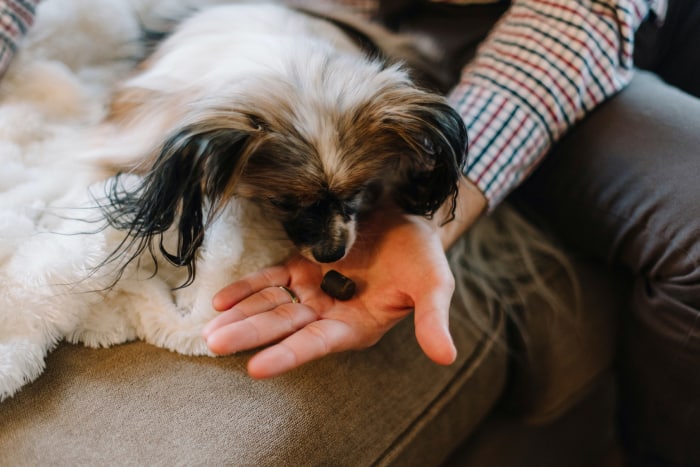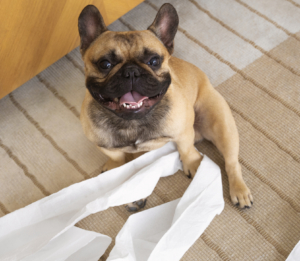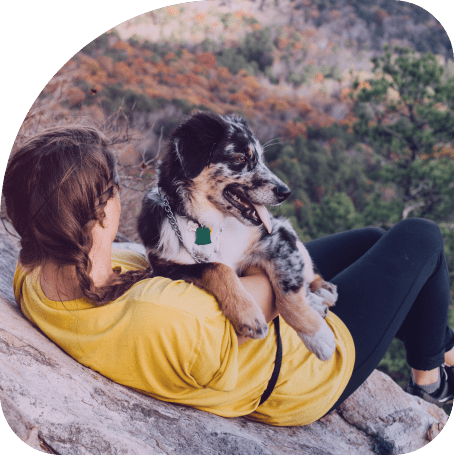This article is here to help you understand the concepts of luring, bribing, and rewarding, and the importance of transitioning from one to the next. You don’t want to get stuck in the luring and bribing phases. Your goal as you train your dog should be to get to the rewarding phase as quickly as possible.
Luring is the action of putting a treat to a dog’s nose and manipulating where their head goes because their nose will stay close to the food.
For example, if you want them to sit, you would put the treat close to their nose, move the treat slowly upwards, and your dog’s nose will follow the treat and move up as well. While their nose moves upwards, their bum will move downwards. Kind of like a teeter-totter. Think of it this way: wherever their face goes, their body will follow, and if you can manipulate where their head goes, their body will naturally follow suit.
You can use luring to teach a dog different physical positions by getting them to move their body in certain ways, teaching them the biomechanics of how their body feels in those positions. When puppies are young, we can lure them into learning how to sit, lie down, move their body into a standing position, turn in circles, come when called, and so much more.
You can use luring in the beginning phase of teaching a dog pretty much anything.
That being said, you don’t want to get stuck in this phase because you run the risk of ending up with a dog that will only listen when food is right in front of its nose. Then what happens if you don’t have food? You’re screwed.
To transition away from luring, you want to move to the next phase as quickly as possible: bribing.
Bribing is where you show the dog you have food (or perhaps a toy they love), and then put that reward away.
Then, make the same motion you used before when you were luring them, except this time there’s no food in your hand, but your hand still looks like there’s food in it! So again, show them the food, put it away, and then quickly make the same motion as if you’re luring them with an empty hand. You’re essentially faking them out, but you’re also teaching them to trust the process.
As soon as they do what you want them to, for example, they sit down, you immediately pull out the reward and give it to them! So you’re essentially saying, “Look at what I have! But first you have to listen to me, then you’ll get it!”
To practice, try this a bunch of times in a row:
- Show them food
- Hide the food
- Do the hand motion
- Then reward them for listening!
With consistency, and a handful of repetitions, you’ll see the light bulb go off and they’ll start to catch on. “My human put the reward away, but if I still pay attention and respond to what they’re asking, that reward will come back and be given to me!” The bribing phase is all about repetition. You are getting that muscle memory in for both of you, teaching them to trust the process and trust that you will in fact reward them for listening, as well as creating an association to a future hand signal.
Once they’re consistently getting it – they see the reward, they watch you put it away, then they still do whatever you ask of them and trust that they will get that reward afterward… then you can finally transition to rewarding.
Rewarding is when you simply ask your dog to do something with your verbal cue, as well as your hand signal, without showing them the food first,
As soon as your dog does what you’ve asked, you then pull out the food (or a favorite toy) and give them their reward. No showing them what you have first, no saying “what’s this?!”, just simply asking them for something, and then when they respond, you reinforce the heck out of their great choice and celebrate.
Move through these steps as quickly as possible. A lot of people stop at luring or bribing and then always need food visible in order to get their dog to respond. Keep at it! With a ton of practice you’ll see how gratifying it is for both you and your dog when you reach the rewarding-only stage. If your dog does well but then starts to regress, check in with yourself about how consistent you’ve been with your communication and rewards. Take a few steps back, spend a day practicing with luring and bribing again and with that refresher your dog should go right back to only needing rewarding again.
To recap:
- Luring is where the food is close to the dog’s nose.
- Bribing is where you show the food, put it out of sight, ask the dog to do something, and then pay them after they do it.
- Rewarding is ‘Hey, can you do this for me? Awesome. Thanks. Now I’ll show you how worth it that was for you!’
Looking to learn more about the fundamentals of dog training? Sign up for ReadyDog and get access to all our courses! We teach how to communicate with your dog and apply concepts like luring, bribing, and rewarding to each skill.



